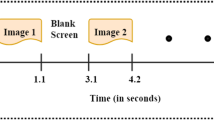Abstract
The present work demonstrates the effectiveness of the combination of time, frequency, time–frequency, and statistical features extracted from the electroencephalogram (EEG) data, with support vector machine (SVM) for lie detection. Predominantly, the features extracted from the empirical mode decomposition (EMD) of the EEG data significantly improve the classification accuracy. A specific number of narrow band oscillatory components, called intrinsic mode functions (IMFs), are obtained after EMD of the data. The first three IMFs are selected to extract three time and three frequency domain statistical features corresponding to each IMF. These features are chosen due to the strong data adaptation capability of EMD for the transient signals such as an EEG. Furthermore, the features are selected keeping in mind the differences in the distribution, average value, and regularity of the guilty and innocent subjects’ brain signals. The proposed combination of extracted features with customized SVM demonstrates better accuracy than the other state-of-the-art feature extraction methods reported earlier. The proposed hybrid combination of features prominently distinguishes the guilty and innocent subjects with the classification accuracy of 99.44%.






Similar content being viewed by others
References
Matsuda I, Nittono H, Hirota A, Ogawa T, Takasawa N (2009) Event-related brain potentials during the standard autonomic-based concealed information test. Int J Psychophysiol 74:58–68
Farahani ED, Moradi MH (2013) A concealed information test with combination of ERP recording and autonomic measurements. Neurophysiology 45:223–233
Teplan M (2002) Fundamentals of EEG measurement. Meas Sci Rev 2:1–11
Jackson AF, Bolger DJ (2014) The neurophysiological bases of EEG and EEG measurement: a review for the rest of us. Psychophysiology 51:1061–1071
Picton TW, Lins OG, Scherg M (1995) The recording and analysis of event-related potentials. In: Boller F, Grafman J (eds) Handbook of neuropsychology, vol 10. Elsevier, Amsterdam, pp 3–73
Lafuente V, Gorriz JM, Ramirez J, Gonzalez E (2017) P300 brainwave extraction from EEG signals: an unsupervised approach. Expert Syst Appl 74:1–10
Polich J, Alexander JE, Bauer LO, Kuperman S, Morzorati S, O’Connor SJ, Porjesz B, Rohrbaugh J, Begleiter H (1997) P300 topography of amplitude/latency correlations. Brain Topogr 9:275–282
González MA, Garduño E, Bribiesca E, Suárez OY, Bañuelos VM (2016) P300 detection based on EEG shape features. Comput Math Method M 2016:1–14
Rosenfeld JP, Hu X, Pederson K (2012) Deception awareness improves P300-based deception detection in concealed information tests. Int J Psychophysiol 86:114–121
Gao J, Tian H, Yang Y, Yu X, Li C, Rao N (2014) A novel algorithm to enhance P300 in single trials: application to lie detection using F-score and SVM. PLoS One. https://doi.org/10.1371/journal.pone.0109700
Mehrnam AH, Nasrabadi AM, Ghodousi M, Mohammadian A, Torabi S (2017) A new approach to analyze data from EEG-based concealed face recognition system. Int J Psychophysiol 116:1–8
Unser M, Aldroubi A (1996) A review of wavelets in biomedical applications. Proc IEEE 84:626–638
Wang D, Miao D, Blohm G (2013) A new method for EEG-based concealed information test. IEEE Trans Inf Forensics Secur 8:520–527
Arasteh A, Moradi MH, Janghorbani A (2016) A novel method based on empirical mode decomposition for P300-based detection of deception. IEEE Trans Inf Forensics Secur 11:2584–2593
Garrett D, Peterson DA, Anderson CW, Thaut MH (2003) Comparison of linear, nonlinear, and feature selection methods for EEG signal classification. IEEE Trans Neural Syst Rehabil Eng 11:141–144
Davatzikos C, Ruparel K, Fan Y, Shen D, Acharyya M, Loughead J, Gur R, Langleben DD (2005) Classifying spatial patterns of brain activity with machine learning methods: application to lie detection. NeuroImage 28:663–668
Subasi A, Erçelebi E (2005) Classification of EEG signals using neural network and logistic regression. Comput Meth Prog Biomed 78:87–99
Demiralp T, Yordanova J, Kolev V, Ademoglu A, Devrim M, Samar VJ (1999) Time-frequency analysis of single-sweep event-related potentials by means of fast wavelet transform. Brain Lang 66:129–145
Samar VJ, Bopardikar A, Rao R, Swartz K (1999) Wavelet analysis of neuroelectric waveforms: a conceptual tutorial. Brain Lang 66:7–60
Huang NE, Shen Z, Long SR, Wu MC, Shih HH, Zheng Q, Yen NC, Tung CC, Liu HH (1998) The empirical mode decomposition and the Hilbert spectrum for nonlinear and non-stationary time series analysis. Proc R Soc Lond A 454:903–995
Oweis RJ, Abdulhay EW (2011) Seizure classification in EEG signals utilizing Hilbert-Huang transform. Biomed Eng OnLine. https://doi.org/10.1186/1475-925X-10-38
Hu X, Pornpattananangkul N, Rosenfeld JP (2013) N200 and P300 as orthogonal and integrable indicators of distinct awareness and recognition processes in memory detection. Psychophysiology 50:454–464
Zhao M, Zheng C, Zhao C (2012) A new approach for concealed information identification based on ERP assessment. J Med Syst 36:2401–2409
Gao J, Wang Z, Yang Y, Zhang W, Tao C, Guan J, Rao N (2013) A novel approach for lie detection based on F-score and extreme learning machine. PLoS One. https://doi.org/10.1371/journal.pone.0064704
Abootalebi V, Moradi MH, Khalilzadeh MA (2009) A new approach for EEG feature extraction in P300-based lie detection. Comput Meth Prog Biomed 94:48–57
Kalatzis I, Piliouras N, Ventouras E, Papageorgiou CC, Rabavilas AD, Cavouras D (2004) Design and implementation of an SVM-based computer classification system for discriminating depressive patients from healthy controls using the P600 component of ERP signals. Comput Meth Prog Biomed 75:11–22
Gao J, Yan X, Sun J, Zheng C (2011) Denoised P300 and machine learning-based concealed information test method. Comput Meth Prog Biomed 104:410–417
Faust O, Acharya UR, Min LC, Sputh BHC (2010) Automatic identification of epileptic and background EEG signals using frequency domain parameters. Int J Neural Syst 20:159–176
Bajaj V, Guo Y, Sengur A, Siuly S, Alcin OF (2017) A hybrid method based on time-frequency images for classification of alcohol and control EEG signals. Neural Comput Appl 28:3717–3723
Abootalebi V, Moradi MH, Khalilzadeh MA (2006) A comparison of methods for ERP assessment in a P300-based GKT. Int J Psychophysiol 62:309–320
Demiralp T, Ademoglu A, Comerchero M, Polich J (2001) Wavelet analysis of P3a and P3b. Brain Topogr 13:251–267
Gao J, Lu L, Yang Y, Yu G, Na L, Rao N (2012) A novel concealed information test method based on independent component analysis and support vector machine. Clin EEG Neurosci 43:54–63
Flandrin P (2007) Matlab/C codes for EMD and EEMD with examples. http://perso.ens-lyon.fr/patrick.flandrin/emd.html. Accessed 23 Aug 2017
Riaz F, Hassan A, Rehman S, Niazi IK, Dremstrup K (2016) EMD based temporal and spectral features for the classification of EEG signals using supervised learning. IEEE Trans Neural Syst Rehabil Eng 24:28–35
Alam SMS, Bhuiyan MIH (2013) Detection of seizure and epilepsy using higher order statistics in the EMD domain. IEEE J Biomed Health Inform 17:312–318
Li S, Zhou W, Yuan Q, Geng S, Cai D (2013) Feature extraction and recognition of ictal EEG using EMD and SVM. Comput Biol Med 43:807–816
Chen SW, Lai YC (2014) A signal-processing-based technique for P300 evoked potential detection with the applications into automated character recognition. EURASIP J Adv Sig Pr. https://doi.org/10.1186/1687-6180-2014-152
Zhang Y, Ji X, Liu B, Huang D, Xie F, Zhang Y (2017) Combined feature extraction method for classification of EEG signals. Neural Comput Appl 28:3153–3161
Cortes C, Vapnik V (1995) Support-vector networks. Mach Learn 20:273–297
Boser BE, Guyon IM, Vapnik VN (1992) A training algorithm for optimal margin classifiers. In: Proceedings of the 5th annual workshop on computational learning theory, Pittsburgh, Pennsylvania, USA, pp 144–152
Burges CJC (1998) A tutorial on support vector machines for pattern recognition. Data Min Knowl Disc 2:121–167
Chang CC, Lin CJ (2011) LIBSVM: a library for support vector machines. ACM T Intel Syst Tech. https://doi.org/10.1145/1961189.1961199
Box GEP, Hunter WG, Hunter JS (1978) Statistics for experimenters: an introduction to design, data analysis, and model building. Wiley, New York
Rosenfeld JP, Labkovsky E, Winograd M, Lui MA, Vandenboom C, Chedid E (2008) The complex trial protocol (CTP): a new, countermeasure-resistant, accurate, P300-based method for detection of concealed information. Psychophysiology 45:906–919
Bajaj V, Pachori RB (2012) Classification of seizure and nonseizure EEG signals using empirical mode decomposition. IEEE Trans Inf Technol Biomed 16:1135–1142
Hsu CW, Chang CC, Lin CJ (2003) A practical guide to support vector classification. http://www.csie.ntu.edu.tw/~cjlin/papers/guide/guide.pdf. Accessed 7 Oct 2016
Author information
Authors and Affiliations
Corresponding author
Ethics declarations
Conflict of interest
The authors declare that they have no conflict of interest.
Additional information
Publisher's Note
Springer Nature remains neutral with regard to jurisdictional claims in published maps and institutional affiliations.
Rights and permissions
About this article
Cite this article
Saini, N., Bhardwaj, S. & Agarwal, R. Classification of EEG signals using hybrid combination of features for lie detection. Neural Comput & Applic 32, 3777–3787 (2020). https://doi.org/10.1007/s00521-019-04078-z
Received:
Accepted:
Published:
Issue Date:
DOI: https://doi.org/10.1007/s00521-019-04078-z




